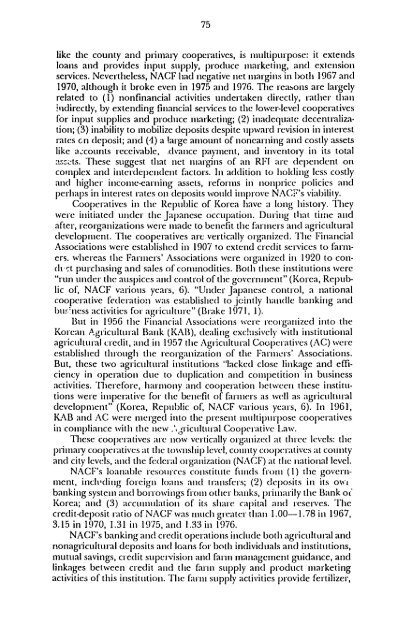I Fiance Apicultural
I Fiance Apicultural
I Fiance Apicultural
You also want an ePaper? Increase the reach of your titles
YUMPU automatically turns print PDFs into web optimized ePapers that Google loves.
75<br />
like the county and plimaly cooperatives, is mhltipurpose: it extends<br />
loans and provides input supply, produce marketing, and extension<br />
services. Nevertheless, NACF had negative net margins in both 1967 and<br />
1970, although it broke even in 1975 and 1976. The reasons are largely<br />
related to (1) nonfinancial activities undertaken directly, rather than<br />
indirecdy, by extending financial services to the lower-level cooperatives<br />
for input supplies and produce marketing; (2) inadequate decentralization;<br />
(3) inability to mobilize deposits despite upward revision in interest<br />
rates cn deposit; and (4) a large amount of nonearning and costly assets<br />
like acounts receivable, .dvance payment, and inventory in its total<br />
s.These suggest that net margins of an RFI are dependent on<br />
complex and interdependent factors. In addition to holding less costly<br />
and higher income-earning assets, reforms in nonprice policies and<br />
perhaps in interest rates on deposits would improve NAC-r's viability.<br />
Cooperatives in the Republic of Korea have a long history. They<br />
were initiated tinder the Japanese occupation. During that time and<br />
after, reorganizations were made to benefit the farmers and agricultural<br />
development. The cooperatives arc vertically organized. The Financial<br />
Associations were established in 1907 to extend credit services to farmers.<br />
whereas the Farmers' Associations were organized in 1920 to condtrct<br />
purchasing and sales of commodities. Both these institutions were<br />
"run under the auspices and control of the government" (Korea, Republicof,<br />
NACF various years, 6). "Under Japanese control, a national<br />
cooperative federation was established to jcintly handle banking and<br />
bu! :ness activities for agriculture" (Brake 1971, 1).<br />
But inl 1956 tle Financial Associations were reorganized into the<br />
Korean Agricultural Bank (KAB), dealing exchisively with institutional<br />
agricultural credit, and in 1957 the Agricultural Cooper atives (AC) were<br />
established through the reorganization of the Farmers' Associations.<br />
But, these two agricultural institutions "lacked close linkage and efficiency<br />
in operation due to duplication and competition in business<br />
activities. Therefore, harmony and cooperation betwCCn these institutions<br />
were imperative for the benefit of farmers as well as agricultural<br />
development" (Korea, Republic of, NACF various years, 6). In 1961,<br />
KAB and AC were merged into the present multipurpose cooperatives<br />
in compliance with the new ' 'ricultural Cooperative Law.<br />
hllese coo)eratives are now vertically organized at tlree levels: the<br />
pfriiaiy cooperatives at the township level, cotty Cooperatives at county<br />
and city levels, and the federal organization (NACF) at the national level.<br />
NACF's loanable resources constitute funds fiom (1) the government,<br />
inchdiiig foreign loans and ti-ansfers; (2) dle)osits in its owl<br />
banking system and borrowings from other banks, primarily the Bank ot<br />
Korea; and (3) accumulation of its share ca)ital and reserves. The<br />
credit-deposit ratio of NACF was much greater than 1.00-1.78 in 1967,<br />
3.15 in 1970, 1.31 in 1975, and 1.33 in 1976.<br />
NACF's banking and credit operations include both agricultural and<br />
nonagricultural deposits and loans for both individuals and institutions,<br />
mutual savings, credit su peivision and farm management guidance, and<br />
linkages between credit and the farm supply and product marketing<br />
activities of this institution. The fartn supply activities provide fertilizer,

















